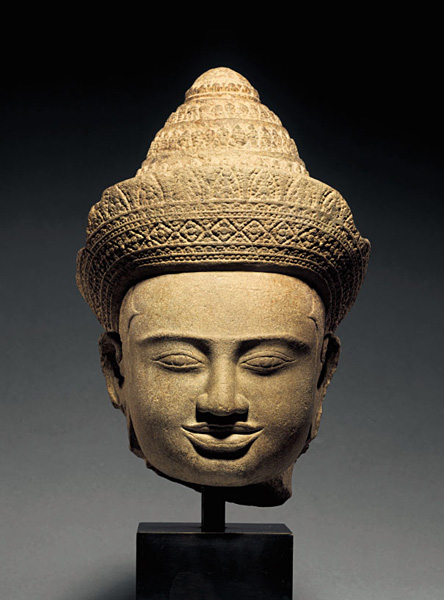|

This life-size female head has a majestic appearance and is most likely one of the popular goddesses of Hinduism - either Lakshmi, the goddess of fortune and sakti (female energy) of Vishnu, or Parvati, the goddess of the universe and sakti of Shiva. This life-size image suggests it may have been originally created as one of the large monumental sculptures, carved fully in the round, to serve the royal complex in Koh Ker.
The head is depicted with eyebrows as a continuous raised ridge separating the broad forehead from the pronounced facial features. The nose is slightly broad, a continuation of Bakong aesthetics; the eyes and mouth are carefully outlined. The elongated earlobes connote royalty and are a concomitant of wearing heavy gold ear pendants that stretch the ear. Now partly broken they still bear signs of piercing to originally accommodate real jewellery. The goddess's hair is finely arranged into individual strands and curls and composed into a high chignon. She wears a superbly designed tiered crown, topped with a lotus bud. The elaborately high diadem has a complex decor with an exquisitely rendered design including scrolling arabesque floral forms and embellished with small decorative shaped medallions, a standard motif in Koh Ker art. The decoration is surpassed in quality by that shown on the back of the crown, (see the photo on the following page), revealing the superiority and freedom of the artistic imagination in the Koh Ker period.
The Koh Ker period (circa 921 A.D.-945 A.D.) was one of the most extraordinary intervals in Khmer history from the perspective of both art and politics. In 921 A.D., Jayavarman IV revolted against the legitimate authority and divided the kingdom to set up a new capital, a royal complex which was constructed on a grand scale, approximately 50 miles Northeast of Angkor. Following the stylistic ideal of the Bakeng style in the early 10th century, the heads of the Koh Ker style are characterised by relatively square faces and with eyebrows in a continuous raised ridge, separating the broad forehead from the facial features. The eyes are engraved with open pupils, the nose is slightly broad, and together with the mouth they are carefully outlined. Typical characteristics of the period are in addition the style of the diadem, the full round cheeks, the treatment of the hair and the physiognomy. The similarity with images dating of the Pr� Rup period, especially the reverse of the diadem with its elaborately sculptured design, suggest the head dates towards the end of the Koh Ker period, circa 940 A.D.
The aesthetic qualities of this impressive head derive from the harmonious balance of volumes, the beautiful contours, the skilfully modelled diadem and features, and the fine polished hard stone surface which is complemented with a beautiful patina. The face of the goddess is depicted with fully rounded forms and with an open sensual and attractive smile which provides an air of charm and dignified liveliness. The head is a rare and magnificent life size example of an Khmer-ideal of female beauty prevalent during the Koh Ker period.
Provenance: Formerly in a private collection, England since 1979.
Detail: back of the head
|

